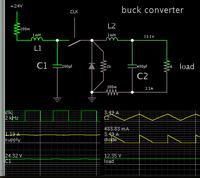mugheesnawaz
Member level 1
Hi all.
i am designing buck converter to step down 24 volts to 12 volts to charge a battery.
so far i am successful in stepping down the voltage but the main issue which i am facing is that input current is higher than output current which should be the other way around.
i am using ir 2112 as gate driver.kindly tell me where i am wrong because buck converter should step down voltage and step up current.

View attachment Buck with ir2110 (FYP).rar
i am designing buck converter to step down 24 volts to 12 volts to charge a battery.
so far i am successful in stepping down the voltage but the main issue which i am facing is that input current is higher than output current which should be the other way around.
i am using ir 2112 as gate driver.kindly tell me where i am wrong because buck converter should step down voltage and step up current.

View attachment Buck with ir2110 (FYP).rar

